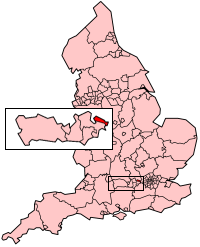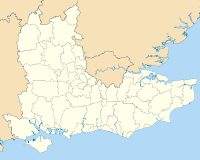Slough
- For slough (In the UK, pronounced to rhyme with bough; In the US, pronounced 'slew') as a type of aquatic feature, see Slough (wetland).
| Borough of Slough | |
|---|---|

| |
| Geography | |
| Status: | Unitary, Borough |
| Region: | South East England |
| Ceremonial County: | Berkshire |
| Area: - Total |
Ranked 334th 32.54 km² |
| Admin. HQ: | Slough |
| ONS code: | 00MD |
| Demographics | |
| Population: - Total (2002 est.) - Density |
Ranked 158th 121,202 3,725 / km² |
| Ethnicity: | 63.7% White 27.9% S.Asian 5.1% Afro-Carib. |
| Politics | |
| Slough Borough Council http://www.slough.gov.uk/ | |
| Leadership: | Leader & Cabinet |
| Executive: | Independent + Conservative + Liberal Democrats |
| MP: | Fiona Mactaggart |
Slough (pronounced to rhyme with bough) is a town and unitary authority in the county of Berkshire in the south of England. In the 2001 census the population was 119,070.
Original villages which now form suburbs of modern-day Slough are: Britwell, Chalvey, Cippenham, Colnbrook, Langley, Poyle, Upton, Wexham and much of Burnham.
History
Most of the area was traditionally part of Buckinghamshire and formed over many years by the amalgamation of villages along the Great West Road between London and Bath and Bristol. The first recorded uses of the name occur as Slo in 1196, Sloo in 1336, and Le Slowe, Slowe or Slow in 1437. The name may have derived from the various sloughs (wetland) in the area; although some people think it may refer instead to Sloe bushes growing in the vicinty. Pubs and Coaching Inns grew up along the Great West Road to service the traffic between London and the West. Most people in the area lived in the joint parish of Upton and Chalvey, termed Upton-cum-Chalvey.
The astronomer William Herschel (1738 - 1822), and his sister Caroline, produced the first true map of the universe with a telescope he built in his garden in Windsor Road, Slough. A monument in Windsor Road commemorates his achievement. William married and is buried in St Laurence's Church, Upton, Slough.
The arrival of the railway in 1840, the Grand Junction Canal in 1882, and, during the mid to late 1800s, the arrival of the brickmaking industry into Langley and the area north of the Great West Road, saw dramatic growth northwards encroaching on the very south of the parish of Stoke Poges. This new development saw the population centre of the town move northwards and the name Slough suppressed Upton-cum-Chalvey.
An area of boggy ground to the west of Slough was used to store huge numbers of motor vehicles coming back from the First World War in Flanders. Local engineering companies sprung up to service this ready resource, and, in the early 1920s, these companies formed the Slough Trading Estate, one of the first such Industrial Estates in the world. Spectacular growth and employment ensued, with Slough attracting workers from many parts of the UK and abroad. Large housing estates were formed to cater for these workers and their families, notably Manor Park and Cippenham.
After the Second World War, several further large housing developments arose to take large numbers of people migrating from war-damaged London, notably Britwell, Wexham Court and Langley.
In the early 1970s the main A4 road was routed onto Wellington Street, north of and parallel to the High Street. This re-routing allowed the building of a major shopping complex, Queensmere, between the High Street and Wellington Street.
Slough was incorporated into Berkshire in the 1974 local government reorganisation. On April 1 1995, the Borough of Slough expanded slightly into Buckinghamshire and Surrey, to take in Colnbrook and Poyle. It became a unitary authority on April 1 1998, with the abolition of Berkshire County Council.
Business
In the late 1800s the only major employer apart from the brickfields was James Elliman, who manufactured his Royal Embrocation horse liniment in Wellington Street and Chandos Street. Elliman became a major benefactor to the town.
In 1906, James Horlick, one of the founders of the eponymous malted milk company, opened a purpose-built red brick factory near to Slough Railway Station to manufacture his malted milk product.
Starting in the 1920s, Slough Estates Ltd, the operator of the original Slough Trading Estate, created and operated many more estates in the UK and abroad.
Hundreds of major companies have sited in Slough Trading Estate over the years, with its proximity to London Heathrow Airport and good motorway connections being attractive.
In the 1960s Gerry Anderson's film company was based in Slough, and his Supermarionation series including Thunderbirds were filmed there.
The European headquarters of Mars, Incorporated is based in Slough, and hence the smell of chocolate can often be smelt wafting across the town.
The town is also home to the National Foundation for Educational Research, which is housed in The Mere.
Sense of Humour
The poet John Betjeman wrote, in his 1937 poem Slough as a protest against the 850 factories and a new town in what had been formerly a rural area:
- Come, friendly bombs, and fall on Slough
- It isn't fit for humans now
As a joke, the comedian Spike Milligan presented Slough on TV as a holiday resort.
The BBC comedy series The Office is set in Slough, reiterating Betjeman's view of the place as a depressing industrial wasteland. In fact the character David Brent comments on Betjeman's poem in the series, and it also appears on the inside sleeve of the video and DVD of Series 1.

